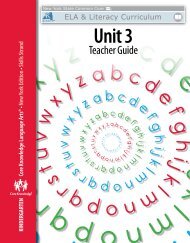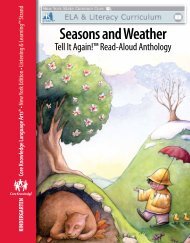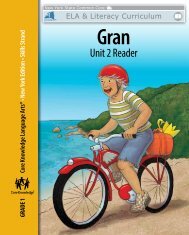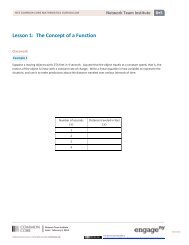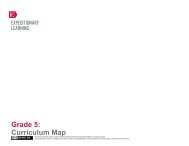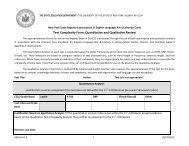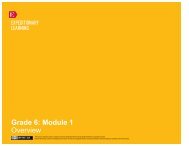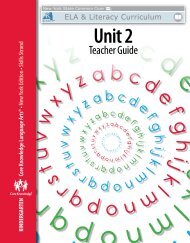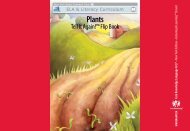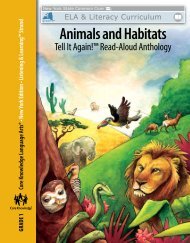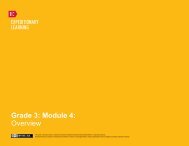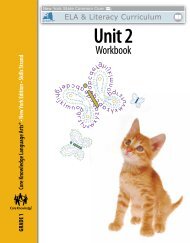Skills Unit 2 Teacher Guide - EngageNY
Skills Unit 2 Teacher Guide - EngageNY
Skills Unit 2 Teacher Guide - EngageNY
Create successful ePaper yourself
Turn your PDF publications into a flip-book with our unique Google optimized e-Paper software.
the students have been taught to process them, e.g., as whole entities for<br />
a sound. (Ultimately as students become more proficient at decoding and<br />
chunking syllables through subsequent grade levels, it really does not<br />
matter whether they visually chunk and decode these words as batt· ed<br />
or bat·ted.) Most students find chunking and decoding these two-syllable<br />
words consisting of root words and suffixes relatively easy.<br />
A greater challenge is encountered when chunking and decoding other<br />
types of multi-syllable words. To be successful in decoding these longer<br />
words, it is helpful if teachers and students recognize certain syllable<br />
types. Most reading specialists identify six different syllable types:<br />
Note: Syllables exemplifying each type are underlined.<br />
• Closed Syllables (CVC, VC, CCVCC, etc.) – always associated with<br />
a “short” vowel sound, e.g. /a/, /e/, /i/, /o/, /u/: let, pad, rod, tin, fun,<br />
pic·nic, un·til<br />
• Magic ‘E’ Syllables (V-C–E) – always associated with a “long”<br />
vowel sound, e.g. /ae/, /ee/, /ie/, /oe/, /ue/: cake, home, like, mule,<br />
Pete, mis·take, stam·pede<br />
• Vowel Digraph Syllables joint, speak, proud, play, dis·may, be·low,<br />
coun·sel<br />
• R-Controlled Syllables art, curb, girl, fort, clerk, tur·nip, ar·tist, fe·ver<br />
• Open Syllables (V or CV) – always associated with a “long” vowel<br />
sound, e.g. /ae/, /ee/, /ie/, /oe/, /ue/: go, me, hi, a·pron, fi·nal,<br />
com·pre·hend<br />
• Consonant–LE Syllables (C–LE): sim·ple, puz·zle, raf·fle, ca·ble, ri·fle<br />
In addition, in CKLA, we think it is also helpful to designate one additional<br />
syllable type:<br />
• Schwa Syllables ben·e·fit, ap·pe·tite, a·bout, hos·pit·al, e·mo·tion<br />
Note: The Consonant–LE Syllable is also a schwa syllable, but we<br />
distinguish it separately because of the way this spelling is chunked<br />
when dividing words into syllables.<br />
To be clear, in order to decode words, students do not need to<br />
identify syllables by these names. The names of the syllable<br />
types are provided here only to establish a common vocabulary<br />
for teachers as they use the CKLA materials. What is necessary,<br />
however, for students to become fluent readers of longer words in<br />
increasingly complex text is that they be able to visually parse certain<br />
168 <strong>Unit</strong> 1 | Appendix B<br />
© 2013 Core Knowledge Foundation



